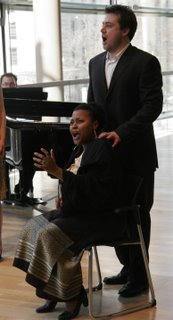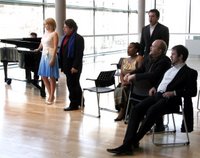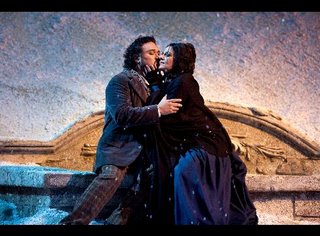« Simulcast » du Metropolitan Opera House de New York
Le samedi 5 avril 2008, à 13 h 30
Distribution (en ordre d'apparition vocale) : Ludovic Tézier (Marcello), Ramon Vargas (Rodolfo), Oren Gradus (Colline), Quinn Kelsey (Schaunard), Paul Plishka (Benoît), Angela Gheorghiu (Mimi), Meredith Derr (Parpignol), Paul Plishka (Alcindoro), Ainhoa Arteta (Musetta), Robert Maher (sergent des douanes), Richard Pearson (agent des douanes).
Production, mise en scène et décors : Franco Zeffirelli
Costumes : Peter J. Hall
Éclairages : Gil Wechsler
Chœurs et Orchestre du Metropolitan Opera House de New York dirigés par Nicola Luisotti
On murmure entre les branches que le film du simulcast de la représentation de La Bohème de samedi dernier est destiné à remplacer le DVD maison, qui date de 1982 : il s’agit de la version mettant en vedette Teresa Stratas, Renata Scotto et José Carreras, sous la direction de James Levine (Pioneer, indisponible). Sans doute est-il permis de préférer la distribution de 1982 qui, entre autres choses, comportait davantage de « grands noms » ou, en tout cas, de noms connus (en plus de ceux qu’on a déjà mentionnés : Richard Stilwell, Allan Monk, James Morris) que celle de 2008, où il n’y a guère que le Rodolfo et la Mimi qui soient des vedettes internationales.
Le divo, Ramon Vargas, a la voix de Rodolfo, mais pas le physique de l’emploi, au contraire de Carreras qui avait les deux. Mais cela on l’oublie vite, tant il est sincère, entier et au sommet de sa forme vocale. Certains lui ont reproché un contre-ut un peu trop prudent, dans le duo de la fin du premier acte, mais ce ne sont là que des vétilles. Il existe entre lui et sa diva une chimie particulière et qui se manifeste, avec splendeur, lorsque, ensemble, ils traversent divers états de la passion, les joies et les douleurs de l’amour.
Angela Gheorghiu, par ailleurs, a à la fois le physique et la voix de Mimi. Son instrument est un peu petit, mais elle compense ce défaut par sa maîtrise vocale et l’intelligence et l’intensité de son jeu de comédienne. À cet égard, elle rappelle Stratas, à cette différence près que le style dramatique de la chanteuse canadienne était beaucoup plus spontané, beaucoup moins calculé que le sien. Alors même que Mme Gheorghiu exécute le moindre geste, chante la moindre note à la perfection, elle nous laisse toujours un peu un retrait de l’illusion. C’est notamment le cas dans la scène finale où, alors que les autres personnages, bouleversés, se pressent autour de son cadavre, étendu sur le lit, elle seule n’a pas l’air de croire qu’elle est vraiment morte.
Le soprano Ainhoa Arteta n’a pas les moyens vocaux de Renato Scotto et ne sera jamais une artiste du même calibre. Mais elle a ce qui a toujours un peu manqué à Scotto : une sensualité authentique. Et quelle fougue ! À partir du moment où elle fait son entrée au deuxième acte, la scène lui appartient, et elle ne la lâchera pas, demeurant l’objet de l’attention universelle jusqu’au tout dernier moment, au risque même de compromettre la mise en scène.
Le public new-yorkais a réservé un accueil enthousiaste aux détenteurs de rôles « mineurs » (si tant est qu’il y en ait dans cette œuvre) qu’il connaissait déjà, tels le vétéran Paul Plishka, en Benoît et Alcidoro, et Quinn Kelsey, en Schaunard, et ce, en dépit de son physique pachydermique. Par contre, on s’est montré beaucoup plus réservé envers Oren Gradus. Le chanteur auquel on risque de s’intéresser de plus en plus, c’est le Français Ludovic Tézier, très admiré en Europe et même au-delà, grâce au DVD, mais encore inconnu de la plupart des opéraphiles américains. Or, il vient de démontrer ce qu’une voix splendide alliée à un solide métier d’acteur peut contribuer à un rôle comme celui de Marcello et, partant, à La Bohème tout entière, dont c’est l’un des rôles pivots. Il faut s’attendre à le revoir à nouveau, et dans des emplois de plus en plus importants, sur la scène du Met.
Au podium, Nicola Luisotti dirigeait comme s’il était en amour avec la partition.
Le jeune maestro (45 ans), originaire de Lucques en Toscane, s’impose depuis quelques années comme l’un des grands chefs italiens de sa génération. Il vient d’être nommé directeur artistique de l’Opéra de San Francisco pour la saison 2008-2009 et il faut s’attendre à ce qu’il devienne lui aussi un habitué du Met et de ses simulcasts, d’autant plus que son répertoire de prédilection est constitué en partie d’ouvrages qui laissent James Levine indifférent, en partie d’œuvres qui ont cessé de l’intéresser.
La mise en scène était celle de Franco Zeffirelli dans – il faut le préciser – sa version new-yorkaise, car c’est un fait que lorsque, en 1981, le Met a invité le metteur en scène florentin à monter une nouvelle production de La Bohème, il y avait déjà près de vingt ans qu’il travaillait à mettre au point son « concept » de l’œuvre, et il n’a pas cessé d’expérimenter depuis. En conséquence, vingt-sept ans après, « sa » mise en scène existe en de multiples variantes dont plusieurs ont mérité les honneurs de la vidéo, et dans certains cas plus d’une fois, comme c’est le cas de celle du Met. À force d’être trimballlée et imitée aux quatre coins du monde, elle est devenue « classique », la vision canonique, si l’on peut dire, d’un opéra qui lui-même l’emporte en popularité sur tous les autres. Le troisième acte a toujours été très admiré. Le premier, par contre, est un peu sombre, un défaut particulièrement accentué au Met samedi dernier. C’était alors exactement la 349e fois qu’on y montait la production en question. L’événement avait déjà, un peu plus tôt dans la semaine, donné lieu à une célébration qui marquait aussi la fin d’une ère. Zeffirelli a quatre-vingt-cinq ans et, quand il n’est pas occupé à prodiguer des conseils vestimentaires au pape Benoît XVI, consacre les énergies qui lui restent à tenter de convaincre l’industrie cinématographique de lui donner les moyens de compléter son dernier film, une suite à son grand succès des années 1970, François et les chemins du soleil.
-Pierre Marc Bellemare
Labels: Angela Gheorghiu, HD Screenings in Cinemas, La Boheme, Metropolitan Opera, Puccini, Ramon Vargas
 Yannick-Muriel Noah (Mimi) and Adam Luther (Rodolfo) in Act 4 of La boheme. (Photo: Heather Lewis)
Yannick-Muriel Noah (Mimi) and Adam Luther (Rodolfo) in Act 4 of La boheme. (Photo: Heather Lewis) personalities.
personalities. 



